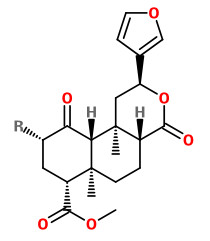Salvia divinorum Epling & Játiva - Lamiaceae - divining sage, salvia of the seers, pipiltzinttzintli (aztec), Azteken-Salbei
Perennial herb, up to 1.50m tall, native to Mexico.
„Salvia divinorum is used by the Mazatec Indians of northeastern Oaxaca, Mexico primarily for its psychoactive
effects which aid in ritual divination (Wasson, 1962, 1963). It is also employed remedially to treat various health conditions… Traditionally the herb is consumed either by chewing the fresh leaves or by drinking the juices of freshly crushed leaves. The effects of the herb when consumed this way depend on absorption of salvinorin A through the oral mucosa before the herb is swallowed… When salvinorin A is vaporized and inhaled the full effects are experienced in about 30 s. There is almost no transition period experienced. The
strongest effects last 5-10 min and then gradually subside over about 20-30 min. As dosage increases above 1 mg the duration of the effects are somewhat increased. A similar evolution of effects is reported for smoked S. divinorum leaves.“
[Salvia divinorum and salvinorin A: new pharmacologic findings., Siebert, D.J., Journal of ethnopharmacology, 43(1), 1994, 53-56] http://www.sagewisdom.org/siebertjep94.pdf
„In traditional ceremonies involving native Mazatecs, details in the ceremonies may differ. For instance, the Mazatecs are accustomed to chewing the leaves of S. divinorum directly, but researchers found this impossible due to the extremely bitter flavor of the leaves… Small dose infusions made from four to five pairs of leaves may be taken as a tonic or panacea. Taken in this form, S. divinorum is thought to regulate eliminatory functions, relieve headaches, and alleviate rheumatism. It may also given to the sick and dying to revive them. The Mazatec also believe that ska Maria will cure panzon de barrego (sic), or a swollen belly, which is supposedly caused by a curse from a brujo, or evil sorcerer… Inhalation of the vaporized salvinorin
A was tested, however, and proved to be the most efficient and dramatic method of salvinorin A intake to produce hallucinations. Threshold effects were usually noted at 200-500µg, and hallucinations occurred within 30 seconds, rather than the 10-15 minutes required by oral ingestion (Siebert 1994). With activity apparent at the 200µg level, salvinorin A is now the most potent entheogen known thus far, and one of the most potent natural compounds discovered.“
[Salvia divinorum: The botany, ethnobotany, biochemistry and future of a Mexican mint., Marushia, R., 2002] http://www.cyjack.com/cognition/Salvia.pdf
 salvinorin A (R=OAc) and B (R=OH)
salvinorin A (R=OAc) and B (R=OH)
„The diterpene salvinorin A from Salvia divinorum has recently been reported to be a high-affinity and selective κ-opioid receptor agonist (Roth et al., 2002). Salvinorin A and selected derivatives were found to be potent and efficacious agonists in several measures of agonist activity using cloned human κ-opioid receptors expressed in human embryonic kidney-293 cells. Thus, salvinorin A, salvinorinyl-2-propionate, and salvinorinyl-2-heptanoate were found to be either full (salvinorin A) or partial (2-propionate, 2-heptanoate) agonists for inhibition of forskolin-stimulated cAMP production… Salvinorin A was found to be a full agonist, being significantly more efficacious than (trans)-3,4-dichloro-N-methyl-N-[2-(1-pyrrolidinyl)-cyclohexyl] benzeneacetamide methane-sulfonate hydrate (U50488) or (trans)-3,4-dichloro-N-methyl-N-[2-(1-pyrrolidinyl)-cyclohexyl] benzeneacetamide methane-sulfonate hydrate (U69593) (two standard κ-opioid agonists) and similar in efficacy to dynorphin A (the naturally occurring peptide ligand for κ-opioid receptors). Salvinorin A thus represents the first known naturally occurring non-nitrogenous full agonist at κ-opioid receptors.“
[Salvinorin A, an active component of the hallucinogenic sage Salvia divinorum is a highly efficacious κ-opioid receptor agonist: structural and functional considerations., Chavkin, C., Sud, S., Jin, W., Stewart, J., Zjawiony, J.K., Siebert, D.J., Roth, B.L., Journal of Pharmacology and Experimental Therapeutics, 308(3), 2004, 1197-1203]
„Salvinorin-A, the main psychoactive constituent in S. divinorum, is a non-nitrogenous neoclerodane diterpene with an affinity for the kappa opioid receptor (KOR; Roth et al., 2002). Despite its intense perception-modifying effects in humans, in vitro studies have shown that salvinorin-A does not bind to 5HT2A receptors, the molecular target of classic psychedelics like lysergic acid diethylamide (LSD), mescaline, psilocybin, and dimethyltryptamine (Roth et al., 2002; Prisinzano, 2005). …
Salvinorin-A led to a disconnection from external reality, induced elaborate visions and auditory phenomena, and modified interoception. The lower doses increased somatic sensations, but the highest dose led to a sense of a complete loss of contact with the body.“
[Maqueda, Ana Elda, et al. „Salvinorin-A induces intense dissociative effects, blocking external sensory perception and modulating interoception and sense of body ownership in humans.“ International Journal of Neuropsychopharmacology 18.12 (2015): pyv065.] https://www.ncbi.nlm.nih.gov/pmc/articles/PMC4675976/
